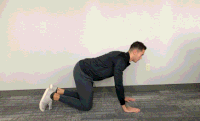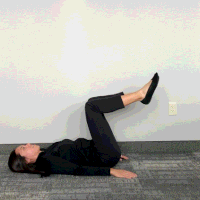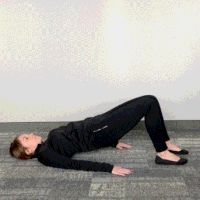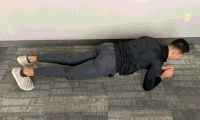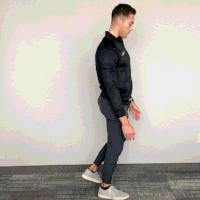Core Strengthening for Everyone
What are your fitness goals? Some of us want to run hundred-mile races or squat twice our body weight. But most of us have simpler goals like getting to a place where taking the stairs or getting down on the ground feels comfortable, and that’s OK! Wherever you are in your fitness journey, build a foundation that allows you to move how you want.
An excellent place to start is building up your core strength, which can protect your spine, ease lower back pain, and improve balance, stability, and posture. We need some degree of core strength and stability in nearly every move our body makes. A weak, tight, or unbalanced core can undermine your ability to comfortably perform everyday activities like bending, lifting, twisting, and carrying. Even sitting and using a computer or taking phone calls can stiffen muscles in your back, causing pain, if your core isn’t strong enough to support you. The good news is that it’s never too late to start strengthening your core. First, check with your physician to ensure you’re cleared for these types of exercises.
Since there are so many ways to do it, your core-strengthening options are limited only by your imagination! Below is a fun, but challenging, core circuit to mix-up your current routine or add to your repertoire. While weights and equipment can be helpful, we’ve opted for exercises that use just bodyweight. Make sure you perform core exercises with focus and awareness, aiming to brace and engage your core rather than use momentum. It’s OK to pause and find your balance, if needed, before moving onto the next repetition of a challenging movement like bird-dogs or single-leg deadlifts. If you’re not a novice to core training, try out the advanced progression and scale up the number of sets/repetitions of each exercise.
Bird Dog
How-to: Start on all fours with your knees hip-width apart and hands under your shoulders. Keep your feet flexed, pointing towards your body. Brace (stiffen) your core muscles to position your spine neutrally (flat) and to avoid excessive sagging or arching. With your thumb pointing toward the ceiling, raise your right arm to shoulder height (parallel to the floor). At the same time, lift and extend your left leg. Only raise your limbs to a height where you can maintain a neutral (flat) spine position. Keep your head aligned with your spine and focus on keeping your hips and shoulders parallel to the floor, avoiding tilting. Gently lower your right arm and left leg to the starting position and repeat with your opposite arm and leg. Make it more challenging: Center your right knee on the center of a BOSU ball dome and place both hands on the floor beneath your shoulders. Extend your left leg to hip height while raising and extending your right arm to shoulder height. Keep your thumb pointing to the ceiling. Hold for 20 seconds or longer, then switch to opposite limbs. |
Lying Toe Taps
How to: Lie on your back on an exercise mat or floor with your arms at your sides. Brace your core by flexing your abdominal muscles and drawing your belly button to your spine. Lift your knees to a 90-degree angle. With control, lower and extend your right foot to lightly touch the floor while keeping your left leg stationary. Slowly return your right knee to the 90-degree starting position. Repeat on the left leg. Make it more challenging: Lower and extend both legs simultaneously, ensuring your lower back remains in contact with the mat or floor. |
Marching Hip Bridge
How-to: Lie on your back on an exercise mat or floor with your arms at your sides. Lift your hips into a hip bridge, keeping a neutral pelvis. While holding the hip bridge, lift your right foot off the floor, keeping your knee at 90-degrees. Return the right foot to the floor and repeat with the left leg. Make it more challenging: Single Leg Glute Bridge: Set up a basic glute bridge and extend (straighten) one leg to the ceiling. Hold and squeeze your glutes for a two-count at the top, then lower the bridge down to the floor with control. Make sure you squeeze your glutes at the top and avoid overextending your lower back. Complete all repetitions on one side before switching to the opposite leg. |
Forearm Plank with Toe Taps
How-to: Position yourself into a forearm plank, squeezing your glutes, and bracing your core. Imagine there is a straight, strong line from your head to toes. If this feels challenging, work on holding this plank position before progressing. Perform alternating toe taps by hovering your right foot, pushing it away from your body, touching the floor, then returning to the start position. Repeat with the left leg. Make it more challenging: Perform the exercise with forearms positioned on a BOSU dome. |
Single-Leg Deadlift
How-to: Stand with your feet at hip-width. Plant your right foot firmly on the floor and lift your left leg. Inhale and hold your breath, then hinge at your hips/pelvis, maintaining a neutral spine and squared shoulders and hips. With your fingertips pointed towards the ground, lower your body until you feel a significant stretch in your hamstrings. You can bend your right knee, if needed, to create a deeper hinge. Think about pushing your glutes and hips behind you. Use a powerful exhale to push through your right foot and return to the starting position. Pause and find your balance if needed. Repeat all repetitions on one side before switching to the other leg. Make it more challenging: Hold a dumbbell, kettlebell, or weight plate in each hand while performing the exercise. |

